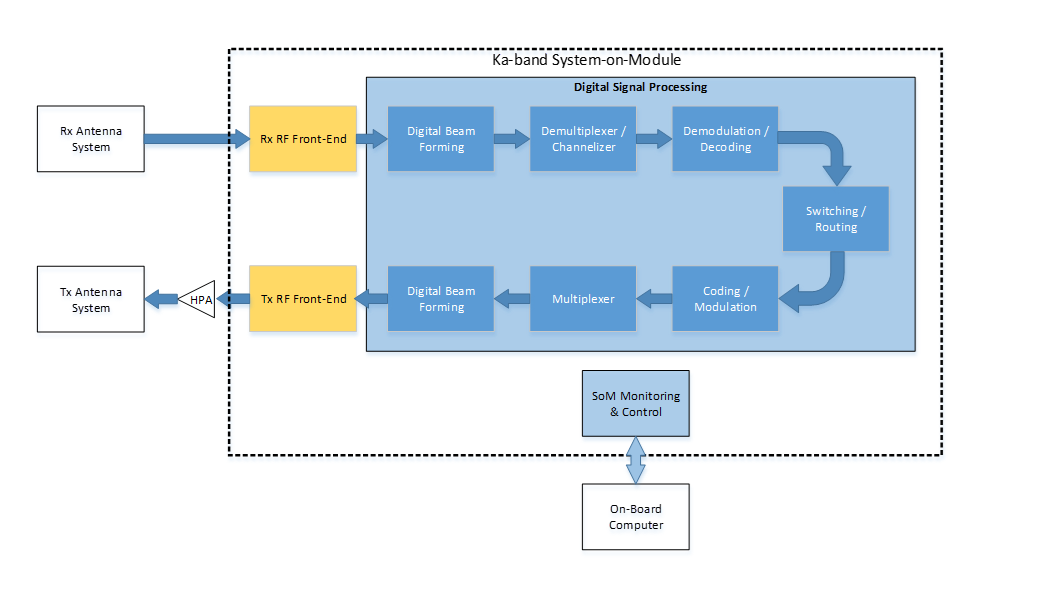-
StatusOngoing
-
Status date2025-06-13
-
Activity Code5E.021
The main objective is the specification, design, bread-boarding and test of a Ka-band flexible and reconfigurable system-on-module (SoM), centred on a highly integrated hardware and software programmable Radio Frequency (RF) system-on-chip (SoC). It includes the RF, analogue and digital functions.
A scaled engineering model of the proposed Ka-band SoM, based on commercial off-the-shelf (COTS) components, is manufactured. It consists of an assembly of several custom-design printed circuit boards, comprising basically a main board with the monolithic RF SoC (including specific firmware and software) and analogue circuits at a high intermediate frequency and daughter RF boards for the frequency down-conversion and up-conversion from or to Ka-band. It is representative of a Ka-band SoM payload equipment for a small low Earth orbit (LEO) satellite in form, fit and critical functions.
We demonstrate its flexibility, adaptability, and configurability in terms of frequency allocation, channel bandwidth, data rate, waveform, switching, multiplexing, beam forming, etc., through several different applications. Its performance and capabilities in terms of noise figure, frequency stability, phase noise, throughput, bit error ratio (for a regenerative payload), etc, are verified.
The project increases the technology readiness level of the intended Ka-band SoM payload equipment to Technology Readiness Level (TRL) 5.
The key challenges in this activity are the miniaturization, integration, and reduced power consumption of state-of-the-art technology, for optimising the size, weight, and power (SWaP) and ensuring the compatibility with small LEO satellites.
We target high-end and reproducible performance, through a largely digital implementation that avoids most of the analogue imperfections, imbalances, temperature variations and ageing effects, and compensates for those of the RF front-ends with digital techniques.
The Ka-band SoM is expected to lead to a reduction factor of nine to 12 in footprint, 10 to 12 in mass and two to 4.5 in power consumption with respect to similar existing products, comparing the baseband/IF subsystem.
Additionally, the product provides the additional significant gain from the fact that the RF sections (Ka-band front-ends) will be integrated in the Ka-band SoM: further increasing the improvement in SWaP.
In total, the intended Ka-band SoM brings a disruptive SWaP improvement with respect to existing on-board processing (OBP) products.
- A small SWaP satcom transceiver with eight Ka-band transmitters and eight Ka-band receivers, which can collaborate to enable transmit (Tx)- and receive (Rx)-side beamforming.
- The architecture allows to combine multiple units to extend the functionality.
- Regenerative processing allows to optimise the channel usage and individual link budget.
- The unit relies on a digital configuration, which can easily be upgraded after production.
The Ka-band SoM is an advanced software-defined satellite communication payload for small LEO satellites. It provides:
- a receiving antenna sub-system with eight input RF interfaces at Ka-band, with gain control
- a transmitting antenna sub-system with 8 output RF interfaces at Ka-band
- a digital TM/TC interface with the on-board computer

The activity is organised in four tasks:
- Task 1: Overview of state of the art constellations and comparable products, and their usage of bandwidth and beamforming, followed by derivation of a set of finalised technical specifications and a preliminary design;
- Task 2: A detailed design justified by mathematical and simulated performance, and implementation of the scaled EM;
- Task 3: Validation of function and performance, of the scaled EM;
- Task 4: A technology assessment and development plan
The following milestones applied: SRR, BR, PDR, DDR, TRR, and FR.
The SRR datapack is delivered for review.



